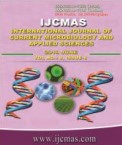


 National Academy of Agricultural Sciences (NAAS)
National Academy of Agricultural Sciences (NAAS)

|
PRINT ISSN : 2319-7692
Online ISSN : 2319-7706 Issues : 12 per year Publisher : Excellent Publishers Email : editorijcmas@gmail.com / submit@ijcmas.com Editor-in-chief: Dr.M.Prakash Index Copernicus ICV 2018: 95.39 NAAS RATING 2020: 5.38 |
Exploiting the production potential of high yielding rice varieties through agronomic management is one of the alternatives to feed the ever growing population. For this, fertilizers from different sources and modern planting techniques have contributed substantially to the spectacular increase in rice yield and to improve soil properties. In order to study the effect of planting techniques and integrated nutrient management in rice. A field experiments was conducted at Crop Research Centre of Sardar Vallabhbhai Patel University of Agriculture & Technology, Meerut (Utter Pradesh) during Kharif 2017. The experiment was laid out in split plot design with three replications. The treatment consisted of three planting techniques (P1- conventional puddled transplanting (CT-TPR), P2- wide raised beds transplanted rice (WB-TPR) and P3- reduced till transplanted rice (RT-TPR) and ten integrated nutrient management (F1- control, (no fertilizer), F2- RDF (150-60-40 kg NPK/ha), F3- 75%RDF + FYM 5 t/ha, F4-75% RDF + FYM 5 t/ha + Zn, F5- 75% RDF + FYM 5 t/ha + BF, F6- 75% RDF + FYM 5 t/ha +BF + Zn, F7- 100% RDF + FYM 5 t/ha, F8- 100% RDF + FYM 5 t/ha + Zn, F9- 100% RDF + FYM 5 t/ha + BF and F10- 100% RDF FYM 5 t/ha+BF+ Zn in this way there were 30 treatment combinations. The values of growth contributing characters viz. plant height (cm), number of tillers m-2, dry matter accumulation (g m-2), and yield attributes like number of panicles m-2, length of panicle (cm), number of panicle-1, grain weight panicle-1, test weight (g), grain and straw yield (q ha-1) of rice were increasing significantly with conventional puddled transplanted method (P1) followed by wide raised beds transplanted method (P2) and significantly superior over rest of the treatments. In case of integrated nutrient management the growth characters like plant height (cm), number of tillers m-2, dry matter accumulation (g), yield attributes’ number of panicle m-2, length of panicle, grain weight panicle-1, test weight (g), grain and straw yield (q ha-1) of rice were maximum under F10 (100% RDF+5t/ha FYM + BF + Zn) which was at par with F9 (100% RDF +5t/ha FYM +BF) during course of investigation. The maximum gross return and net return were noted under P2 (wide raised beds transplanted rice) with F10 (100% RDF+5t/ha FYM+ BF + Zn) [P2F10] application. The highest benefit cost ratio were recorded with WB-TPR SRI method with (100% RDF+5t/ha FYM+ BF + Zn) treatment (P2F10) followed by WB-TPR with (100% RDF+5t/ha FYM+BF) (P2F9) they proved more remunerative then other treatment combinations. CT-TPR used higher amount of water than WB-TPR, with water saving of 14.5% in WB-TPR. Significantly higher water productivity was recorded in WB-TPR as compared to CT-TPR.
 |
 |
 |
 |
 |